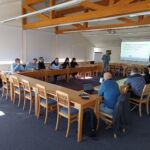On 19 February 2025, the main building of the Institute of Physics of Materials of the CAS (IPM) hosted the kick-off meeting of the project Partnership for Safety in Sustainable Transport and Energy (PSSITE), implemented under the call for intersectoral cooperation of the OP JAK managed by the Ministry of Education, Youth and Sports of the Czech Republic. The meeting brought together the project investigators and representatives of participating institutions and companies to jointly coordinate the initial phases of the five-year project worth almost 100 million crowns.
We asked the project principal investigator, prof. Ing. Luboš Náhlík, Ph.D.:
We have long been cooperating with industrial partners from various fields, so we have welcomed the opportunity given by the call for intersectoral cooperation of the OP JAK. We will try to create a platform for intensive development and application of new materials suitable especially for safe deployment in energy and transport, development of new procedures for determining the service life of critical parts of energy equipment and highly stressed parts used in transport equipment. For this idea, we have acquired renowned partners BONATRANS GROUP, a.s., UJP PRAHA, a.s., Aircraft Industries, a.s., Institute of Applied Mechanics Brno, s.r.o., who have been in the field of energy or transport for a long time and are interested in increasing their research potential by cooperating with IFM. We also invited smaller dynamic Brno companies NenoVision s.r.o. and X-Sight s.r.o., as well as a reliable and proven academic partner, the Brno University of Technology. The aim of the partnership is to create a synergy that will enable the research results to be used directly by industrial partners, while at the same time supporting the innovative potential of the companies involved with an emphasis on the sustainable development of joint research activities.
Could you outline what we can expect to be the results of the project or what specific results the project should lead to?
Among the main research outcomes I would mention for example Development of new promising materials for transport applications. Two categories of materials will be developed with industrial partners – lightweight non-ferrous metal-based alloys with optimised properties and new progressive steels with reduced content of deficient elements and reduced specific gravity. In the area of materials suitable for power generation, these will include new materials for high-temperature power plants or a new type of nuclear fuel rod coating with higher durability. At the same time, procedures for predicting the lifetime of these materials and methodologies for their proper testing will be developed. Suitable outputs will be industrially protected and offered for licensing.
For such large-scale research you need an appropriate research infrastructure. Can you say more about that?
Of course. We need to provide significant test facility capacity for both static high-temperature testing and dynamic materials testing. In this respect, the IFM is very well equipped and has considerable capacities, in my opinion unique at least in the Central European region. However, for a successful project, it will be necessary to involve also extensive capabilities in the field of electron microscopy for the characterization of the materials to be prepared. We have considerable experience in this field as well. We have even now succeeded in completing the new building of the Electron Microscopy Centre and are gradually putting the electron microscopes that have been relocated there into operation. Unfortunately, their current capacity would not be sufficient or would not allow further research work apart from the implementation of the PSSITE project, and so two new line electron microscopes will be acquired as part of the project. One for highly specialized work with high resolution and the other a simple bench-top system for rapid imaging providing fast orientation in the microstructure of materials or control of prepared samples for more detailed observation. These facilities will indeed be key to the successful implementation of the project.
Will university students also be involved in the project?
I can say that, as usual, they will. And to a great extent. And not only students connected with the IFM. After all, this was also one of the motivations for inviting colleagues from the Faculty of Mechanical Engineering at Brno University of Technology. We are not only concerned with the involvement of students in the research activities of the project, but we would like to achieve that the results and findings from applied research will be integrated into educational programs and will contribute to the innovation of curricula from bachelor to doctoral studies. We hope that the staff of the partners from the application sphere will also be involved in university teaching or offer corporate internships to students. After all, the system of student internships has been operating successfully at the IFM for several years. In the area of transferring current know-how to university studies, we will cooperate with colleagues from the Institute of Materials Science and Engineering and the Institute of Solid Mechanics, Mechatronics and Biomechanics of the Brno University of Technology, who are very interested in this connection.




